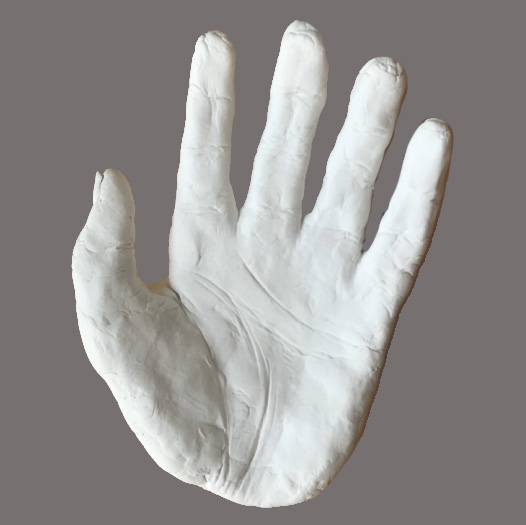The Hand
I used the medium of clay to create a tactile, interactive piece which gives an accurate portrayal of the lifelike quality of her hand; it feels both natural and humanoid to hold yet is by its very nature inanimate and cold. I chose not to paint or decorate my piece and instead left the clay plain white, alluding to her feeling of the loss of character of the hand as well as the grief she felt for the body she used to have and the life that it enabled her to live. Similarly I did not include any major identifying features such as the woman’s wedding or engagement rings nor her manicured nails, moles, freckles and scars – as these as were things that had previously helped define her but the hand she felt was no longer hers at all and was undeserving of such individual identification.
Conversely, the white appearance also represents her hope, that this was a blank canvas upon which she would endeavour to colour a different image. I spent time with her across various intervals throughout the day and her emotions flowed through a number of sentiments: frustration and grief, irritation and longing, and sometimes small glimmers of hope. This hope was especially evident when she yawned as the arm would move albeit involuntarily and was also apparent during a physiotherapy session where she was aided in washing her hands together; an action that she has done thousands of times in her life. As I watched her caress her affected hand with its counterpart, I found myself involuntarily doing the same and clasped my own together. It was this action that helped me to understand her incompleteness and dissociation that of being two halves of a whole.
Both this encounter and the process of making the piece encouraged me to be more appreciative of my sense of touch. The tactile nature of sculpting and sensing as the clay began to dry and changed consistency, I found to be somewhat ironic as I relied upon the very things that she had lost in order to emulate her feelings. Moreover, modelling the clay felt cathartic and a gentle method of reflecting upon the events of that day mulling them over to give a clearer more empathic and profound version of events. I thoroughly enjoyed the clinical experience and felt privileged that this patient divulged her feelings to me.

The realism of the hand, combined with its inanimate paleness places it firmly within the uncanny valley – it’s almost human, almost real, yet still unfamiliar. I think this makes it an effective illustration of the patient’s view of her body; she does not see the hand affected by the stroke as hers. The omission of identifying features on the hand adds to this sense. It is not quite a hand that belongs to a person, it is just a hand.
Great work!
Loss of function is not only a physical readjustment but also an emotional one too. Having the hand have no colour, freckles or even her wedding ring perfectly shows just how detached it is from her: it’s as if it no longer belongs to her. I found it personally moving as a family member of mine still struggles with not being able to do the tasks he once could do without thinking due to a previous stroke and often feels huge frustration and pain over it. It’s so easy to just take something as simple as moving and holding your hands together for granted. I also think the choice of the hand is especially poignant now given the current pandemic which was a reminder of how valuable the ability to touch and connect with one another is.
I feel that the medium used really highlights the realness of this patient’s feelings. Being able to see a lifelike model of her hand in 3D was really striking as it formed a much more personal connection between me and the patient. Reading the story, I could visualise the patient and the complexity of their feelings.
The decision to leave the hand plain white was very striking as it was very symbolic of the dissociation of the patient from their hand, and how they no longer identified it as part of their body. It was as if the life had drained out of the hand, and all that was left was its shell.
I love how the hand has that sense of realism ; the details of the wrinkles and the folds in her palms portraying the life she lived through those hands . I think the skin like look to the hand represents her feelings and her frustration of no longer having what was once hers. I also love how the sculpture of the hand is not connected to an arm therefore not connected to a brain , really emphasises the fact that her hand doesn’t belong to her anymore and it really is just a hand. I love the underlying message of taking our sensations for granted and being more appreciative of the little things that have the biggest effect on our lives
nice work ! 🙂